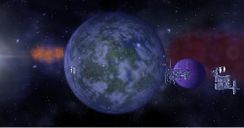Planet New Paris
This article has not been verified to be up to date for the latest version of the Discovery mod. The last edit was made on 20.02.2012 (DD/MM/YYYY). You may help by updating it, often by using the code generator.
| New Paris | |
| Owner | Gallic Royal Navy |
| Location | E6, Ile-de-France |
| Technical information | |
| Population | 5.3 billion |
| Docking | Yes |
| Terrain | Terrestrial |
| Diameter | 12,418 km |
| Mass | 5.95 x 10e24 kg |
| Temperature | -60°C to 63°C |
| Escape velocity | 11.28 km/sec |
New Paris was the first planet colonised by the Gallic sleeper ship's arrival in 84 AS (0 AGS). Biologically, it is similar to Earth's Carboniferous period (late Paleozoic). It has vast forests in equatorial and moderate regions but only a few large animal species capable of breathing the atmospheric oxygen. Oxygen concentration in New Paris is similar to human inhabited Earth, about 24%(it was double that in the Carboniferous period). This didn't allow large insect species to develop, leaving more room for smaller amphibious creatures and preprocessor to birds. colder continental areas were scarcely inhabited and had no large plants. Oceanic wildlife is rich with a wide variety of species, most not bearing any resemblance to Earth-like species. The temperature was similar to Earth in a lot of ways, going above 60°C in equatorial regions and down to -60°C in colder parts.
New Paris had undergone several periods of development, starting with a few isolated colonies with a highly reproductive population. Very soon afterwards, large cities emerged from those settlements, and food demands required a huge amount land for crops and animal farming. in some areas, domestic wildlife was completely replaced by domestic animals and plants. Rapid industrial growth resulted in severe pollution that still affects certain areas of the planet, but most was removed in the subsequent centuries. in about 200 AGS, the population of the planet was nearing 100 mil, and huge urbanised settlements emerged in the planets moderate climate areas near convinient harbours. and all of them were named after old Paris districts, and three of them have their own docking rings (Ile-du-Palais, Saint-Germain, Saint-Denis).
The population grew steadily and reached 5 billion by 600 AGS. Millions of people relocated off-world with massive campaigns to populate worlds with huge resource deposits and industrial capabilities. Like Amiens (Provence) Bourges (Berry), and later Marne (Champaign). apart from the relocation programs, many people left to start "new beginnings" for themselves and too stay in cheaper places for New Paris had become the most expensive place in Gallia; except for resort planets, Marseilles in particular. Remote worlds with far less comfortable climates had far cheaper land and property costs. Ecology issues forced the removal of large industries away from New Paris to space in Ile-De France and beyond. the few old-style factories that remain now serve and museums where citizens can observe the important historical land-marks as seen on 22nd Century Earth. Currently the planet with its 5.3 billion people is considered to be one of the most comfortable place in Gallia. The planet also never lost its status as capital of the house of Gallia, since all the administrative buildings are located there.
